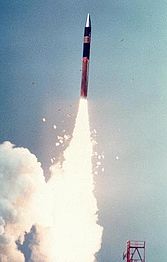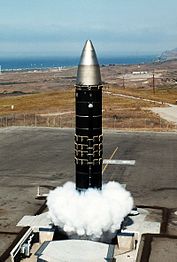STRAT-X
U.S. Armed Forces Military contractors | |
| Outcome | Implementation of several military concepts |
|---|---|
STRAT-X, or Strategic-Experimental, was a
, among others. Journalists have regarded STRAT-X as a major influence on the course of U.S. nuclear policy.Background
In the mid-1960s, reports received by U.S. intelligence agencies indicated that the Soviets were planning to deploy large numbers of highly accurate and powerful
At the same time, the Soviets were designing and constructing increasingly sophisticated
According to Graham Spinardi in his book From Polaris to Trident (1994), STRAT-X was a response by the
Study
The study was named "STRAT-X" in order not to reveal its intentions, and also to eliminate partiality towards
"The systems to be analyzed need not be limited to those recommended by the services, and the STRAT-X study group is encouraged to examine system concepts unrestrained by considerations of potential management problems or political influences."
Extract from a memo from the
On 1 November 1966, McNamara signed an order authorizing STRAT-X, officially initiating the study. During STRAT-X, the working panel was "encouraged to examine system concepts unrestrained by considerations of potential management problems or political influences."
Findings and consequences

Of the nine prospective weapons systems, five were land-based. These were: "Rock Silo"—a system where missiles would be stored in hardened silos of granite bedrock in the Western and Northern United States; "Soft Silo"—a similar system but with easily and cheaply constructed silos; "Rock Tunnel"—a system where missiles would be transported around in deep underground networks before emerging at launch points; "Soft Tunnel"—a similar tunnel but built more cheaply and easily; and "Land Mobile"—a truck-based system where road-transporters traveled at speeds up to 35 miles per hour (56 km/h) constantly around a dedicated and winding road system in 65,000 square miles (170,000 km2) of public land.[11]
Of the remaining four, three were sea-based. These were: "Canal-Based"—a systems where missiles would be sailed in canals to confuse Soviet
Despite the numerous options investigated during the study, none were fully implemented. Although the STRAT-X "Land Mobile" option resulted in the MGM-134 Midgetman and LGM-118 Peacekeeper missiles, the fall of communism throughout the late 1980s and early 1990s resulted in the Midgetman being canceled while still a prototype,[N 3] while only 50 out of the original 100 Peacekeeper missiles were ever fielded.[11] Nevertheless, the study did inspire a number of developments in nuclear weapons delivery systems.[1] In October 1974, the U.S. Air Force successfully conducted an air launch of a Minuteman missile from a C-5 Galaxy, demonstrating the credibility of the "Air Launched ICBM" option of STRAT-X.[12]
Although the U.S. Navy then had several classes of
- Weapons systems inspired by STRAT-X
-
ATrident II submarine-launched ballistic missilefiring its rocket motors after emerging from the ocean.
-
An MGM-134 Midgetman intercontinental ballistic missile shortly after launch.
-
An LGM-118 Peacekeeper missile leaving its hardened silo.
-
AC-5 Galaxyin October 1974.
Legacy
STRAT-X had far-reaching effects on the development and deployment of U.S. nuclear forces. It was the first time that the strategic requirements of the
Footnotes
Notes
- ^ "First, increasingly numerous ICBMs posed a threat to America's own weapons."[3]
- ^ "The survivability of U.S. missiles from a Soviet first-strike attack was given particular consideration by the Strat-X participants ..."[5]
- ^ "The [MGM-134 Midgetman] missile was canceled in 1992, following the collapse of the Berlin Wall and the end of the Cold War."[10]
References
- ^ a b c d e f g h i Grier 2010, p. 53.
- ^ "About SSP: September 1966 ~ 1975". U.S. Navy. Navy.mi. Archived from the original on 12 November 2012. Retrieved 28 September 2013.
- ^ a b c d e Grier 2010, p. 52.
- ^ "R-36M / SS-18 SATAN". Federation of American Scientists. FAS.org. 29 July 2000. Retrieved 24 February 2012.
- ^ a b Polmar and Moore 2004, p. 184.
- ^ Spinardi 1994, p. 113.
- ^ Parsch, Andreas (2003). "BGM-75 AICBM". Directory of U.S. Military Rockets and Missiles. Designation-systems.net. Retrieved 1 June 2012.
- ^ a b c "ULMS". Federation of American Scientists. FAS.org. 30 May 1997. Retrieved 24 February 2012.
- ^ a b c Burr, William (6 January 2010). "The STRAT-X Report and Its Impact". National Security Archive. Retrieved 24 February 2012.
- ^ a b c d e Grier 2010, p. 54.
- ^ a b c d Grier 2010, p. 55.
- ^ "History Milestones". U.S. Air Force. AF.mil. Archived from the original on 18 October 2012. Retrieved 24 February 2012.
- ^ Clearwater 1996, p. 31.
- ^ "Fleet Ballistic Missile Submarines – SSBN". U.S. Navy. Navy.mil. 10 November 2011. Retrieved 24 February 2012.
- ^ "Guided Missile Submarines – SSGN". U.S. Navy. Navy.mil. 10 November 2011. Retrieved 25 February 2012.
Bibliography
- Clearwater, M. John (1996). Johnson, McNamara, and the Birth of SALT and the ABM Treaty 1963–1969. ISBN 1-58112-062-1.
- Grier, Peter (January 2010). "STRAT-X" (PDF). Air Force (magazine). Vol. 93. Arlington, Virginia: )
- Polmar, Norman; Moore, Kenneth J. (2004). "The Ultimate Weapon II". Cold War Submarines: The Design and Construction of U.S. and Soviet Submarines. Dulles, Virginia: Potomac Books. ISBN 1-57488-594-4.
- Spinardi, Graham (1994). "STRAT-X, ULMS, and Trident I". From Polaris to Trident: The Development of US Fleet Ballistic Missile Technology. ISBN 0-521-41357-5.





